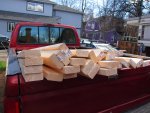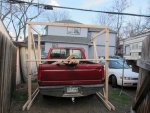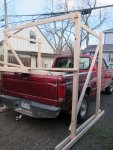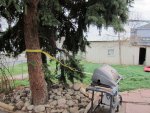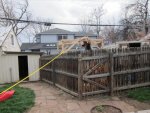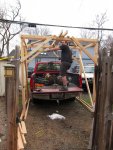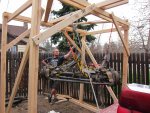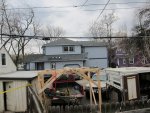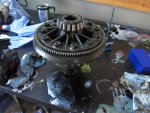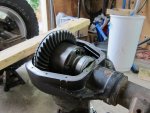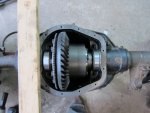For those of you who aren’t familiar with Fords, here is a brief history lesson on the front suspension design of F250 and F350’s from the mid 90’s to now as I know it. Some of you may ask why start with the mid 90’s, we all know Ford stopped making trucks in ’79 (or was it ’97)? Well, I have a ’96, and going back even ten more years is well beyond the scope of my limited knowledge and patience. I apologize in advance for the long post and lack of pretty pictures. Those of you whose eyes glaze over Jezza style when James May starts talking suspension; I suggest you skip this post.

For the old body style fords (OBS) your options were an F250 w/ a D50 TTB leaf sprung front, or an F350 w/ a D60 leaf sprung solid axle. The D50 TTB is not held in high regard by most Ford fans as most of its selling points (lots of travel, great ride) are negated by the leaf springs which bind as the arms move through their travel. The D50 has great potential for a go-fast style rig, but is severly lacking in stock form and requires a fair bit of suspension knowledge and fabrication to get there (see Baja250, simply awesome). The D60 is generally thought of as the right choice for a truck like this, and after much research I would have to agree. While the Baja 250 is a great example of what can be done with the TTB, for the average shade tree mechanic the D60 is just more appropriate for a heavy truck.
From what I gather, the factory F350 D60 rides like a brick, and this is mainly due to the leaf spring shackle located in front of the axle. Basically when you hit a bump and the leaf springs compress, the extra length is taken up by the moving shackle (in front of the axle). This moves the axle forward slightly as the suspension compresses, and essentially forces the axle into the bump as opposed to away from it. A common mod is a reverse shackle kit (RSK) so that the axle moves backwards away from bumps as it compresses. At the same time, many will install longer springs from a super duty for an even more compliant ride. The combination of an RSK and longer springs together is supposed to yield an excellent ride for a 1-ton truck.
Why Ford chose to use a front spring hanger on the OBS trucks is beyond me as I am not a suspension engineer. They obviously had a reason for choosing a front vs rear spring hanger, but I do not know what it is, bump steer? Negative handling quirks? It’s generally a good idea to not muck up something like factory suspension unless you know what you’re doing, but the RSK seems to be working successfully on many many trucks.
In ’99, the super duties came out, and all 4x4’s had a leaf sprung solid axle. I believe D50 for the F250 up through 2002 or so, and D60 afterwards. All F350’s got the D60 up front. I don't know if these came with a rear shackle configuration from the factory, but I would assume they did as I don’t know of any shackle reversal kits for the super duty. The bolt pattern changed w/ the super duties (8x6.5 to 8x170mm?) so wheels were no longer compatible with the earlier Fords.
The beloved D60 continued much the same as previous years, but axle width and spring perches changed to accommodate a different frame design. The simple and serviceable roller bearings of previous D60’s were replaced with (cheaper?) unit bearing hubs. Unit bearing hubs are non-serviceable, and as I understand can fail without the audible bearing growl we have become accustomed to, leaving you stranded by the side of the road with a large repair bill. Checking for play in the bearings is the proper way to diagnose a warn unit bearing, don’t trust your ears! From what I have read, the aggressive offset on super duty wheels (especially when ran with larger tires and aftermarket wheels) contributed to premature failure of many unit bearing assemblies. How big of an issue this really is I don’t know, but it is brought up pretty regularly as a downside of the first gen super duty. The axles can be converted back to conventional roller bearings for around 1-2k depending on the vendor. The rear axle was changed from a sterling 10.25 to a 10.5, and drum brakes to disks which I’m told is a major upgrade in the braking department.
In 2005 the front D60 was changed over to a coil sprung style with radius arms. The axle as a whole is just beefier than past versions. Bigger brakes, tie rods, and unit bearings along with 35 spline axles. The track width was also widened. The bigger unit bearings and less wheel offset has greatly reduced the number of unit bearing failures from my understanding. I don’t know if that translates it into a non-concern, but certainly less of a concern.
The new coil sprung setup is said to perform very well both on and off road, especially with a lift and link arms in place of the factory radius arms. One big advantage of coils over leafs is the ability to run progressive rate springs, which allow you have a soft initial rate for small bump absorption, and a firmer secondary rate for larger bumps and loaded stability. An offshoot is a much tighter turning radius as you’re not limited by tire to leaf spring clearance. Anyone that owns a larger leaf sprung truck should be able to appreciate this one.
We all know the advantages of the simple tough leaf sprung D60, so why would I be so stupid and try and fit a coil sprung axle with (questionable) unit bearings at a greatly increased cost? Well, aside for my love of biting off more than I can chew, the brake upgrade (4-wheel discs) and tighter turning radius are huge benefits for me. My CCSB has the worst turning radius of any vehicle I have ever driven, and I imagine the CCLB trucks are even worse. I grew up driving ¾ ton OBS fords, but they were regular cab long box trucks, and while they had terrible turning radii as well, it was nothing like this. I try not to drive my truck around town, but on the occasions I need to, attempting to park is a constant reminder that this thing will be a headache on tight trails when I'm out camping.
Swapping the coil axle under an OBS is a large undertaking, but requires minimal fabrication. Mainly I will need to cut off the front leaf spring perches, drill holes to mount the coil buckets and radius arms, and adapt the steering, brakes, trackbar, swaybar and driveshaft. For the rear I will need to adapt the drive shaft, and possibly relocate the spring pads and shock mounts on the axle.
It may be a few months before I gather the parts needed for the swap, and I also intend on going through both axles while they're off the truck. When I get everything together I anticipate the swap taking a few weekends, but in the words of the great Jeremy Clarkson, "how hard can it be?"
(Disclaimer- this is an oversimplified view from an inexperienced web-wheeler. While I have spent many hours in leaf sprung TTB trucks, the last solid axle truck I drove was a ’73 doge power wagon. All of the preceding information was based on interweb research with zero first hand knowledge. Feel free to comment and criticize as needed.)

